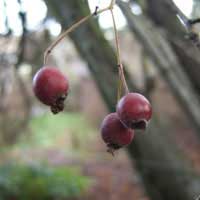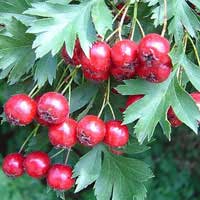 Full List of Fruits
Full List of Fruits  Eastern May Hawthorn
Eastern May HawthornEastern May Hawthorn
![]() Introduction of Eastern May Hawthorn
Introduction of Eastern May Hawthorn
Scientific name - Crataegus aestivalis
Eastern may hawthorn, binomially known as Crataegusaestivalis is a shrub belonging to the Rosaceae family. This small shrub is also known as mayhaw that can usually be seen growing in regions of Southeastern United States, this shrub is grows in low lying regions or mostly wet areas of from eastern Alabama to central Florida and Virginia. This shrub grows up to 9 meters tall that is 29 feet and grows 8 meter wide which equals to 26 feet in width in the case of a normal growing deciduous shrub. The leaves of this tree are dark green in color and are very neatly alternatively arranged. The flowers borne by May hawthorn are adorned on the branches either singularly or can also be spotted in clusters of three or even a pair of two. The pollination of this plant is mainly dependent on midgets as the flowers are hermaphrodites in nature.
Hermaphrodites meaning they have both male and female reproduction organs in the same flower. The edible part of the shrub which is the fruit, appears to be fleshy, red pome borne during the month of May. Thus explaining the name of the fruit itself ' mayhaw'. May haw can grow in various soil conditions but is mainly seen thriving the best in heavy clay soil, preferably moist or wet soil that has enough moisture to withstand the drought. This is to ensure perennial supply of water to the roots. This shrub is strong and sturdy and can also withstand strong winds but having said that it has low tolerance towards winds from the sea and oceans and it gives in to maritime exposure. This plant also is capable to fight through atmospheric pollution and can filter its air for its survival.
Coming to the most interesting part of the mayhaw, the juicy fruit has an acidic flavor and leaves a pleasant after taste. Growing upto 2 cm in diameter this fruit is not as big as pears and peaches. During its ripening season which is mostly may it is treated as one prized possession by all the fruit enthusiast. They are collected in large quantities in southern North America from the wild. This fruit makes a key ingredient in preparation of jams and jellies. A dried form of this fruit is preserved for later use. Inside the plump of the fruit one can spot five large seeds that usually stick together to give an impression that its one seed. The experience of eating may haw is similar to that of eating cherry like fruit with one single seed.
![]() Nutritional Value of Eastern May Hawthorn
Nutritional Value of Eastern May Hawthorn
| Calories | 105 |
| Total Fat | 4 g |
| Sodium | 42 mg |
| Potassium | 0 mg |
| Saturated | 2 g |
| Cholesterol | 9 mg |
| Total Carbs | 13 g |
| Dietary Fiber | 2 g |
| Protein | 4 g |
| Sugars | 9 g |
Apart from all the medicinal properties this fruit bears, the plant is also of great importance. Starting from soil erosion. Hawthorns are planted on river/ water bodies belts and slopes in order to prevent soil erosion and depletion. They are used in bringing about a stability in the soil and control the loss of soil due to afforestation and floods. Dense vegetation always propagates settlement of wildlife. Hawthron shrubs have proven to be good shelter for small migrating birds who feed on these fruits. Apart from migrating birds they also attract whitetail deer who feed on younger stems and mammals who again feed on the juicy fruit. The sturdy strong wood is used to make small hand tools that is used locally.
![]() Health Benefits of Eastern May Hawthorn
Health Benefits of Eastern May Hawthorn
Hawthorn has a long history of being used in preparation of traditional medicine because of its medicinal properties that were discovered before a millennia. The use is popular is popular in both eastern and western side of the world. Heart conditions, kidney problems and digestive disorders were a few ailments known to be cured by consumption of hawthorn based medicines. Apart from the ones mentioned other health benefits include recovery from heart failure, improvement of heart function and improve blood circulation through the arteries.
People affected by the problems of high blood pressure, chest pain and hardening of the arteries can find comfort by consumption of hawthorn on a regular bases. This is because of the presence of anti-oxidant properties and the anti-inflammatory benefits that the fruits comes with. These properties aid in fighting free radicals that in turn are responsible majorly aging and many other health hazards. Heart patients who have chronic heart failure, chest pain (angina), which is caused by low blood flow to the heart have swoon by the benefits of adding hawthorn to their daily diet. It sure did work wonders for them.
![]() Propagation of Eastern May Hawthorn
Propagation of Eastern May Hawthorn
Eastern May Hawthorn can be propagated from both seed and cuttings. Propagation from seed is best done in the late summer or fall. The seeds should be stratified by placing them in a moist bag and storing them in the refrigerator for four to six weeks before sowing. The soil should be well-draining and should be kept moist until the seeds germinate.
Cuttings can be taken from the current season's growth in the late summer or fall. Take cuttings from a healthy branch and remove the lower leaves. Dip the cuttings in rooting hormone and then insert them into a well-draining potting soil. Place the pot in a warm, humid location and keep it moist. Rooting should take place over the next few weeks.
Once the cuttings have rooted, they can be transferred to individual pots and grown in a sunny location. Water the plants regularly and fertilize them every few weeks with an all-purpose fertilizer. The plants should be ready to be transplanted outdoors after one to two years.
When planting the Eastern May Hawthorn outdoors, choose a location with well-draining soil and full sun. Dig a hole that is at least twice as wide as the root ball and just as deep. Place the tree in the hole and backfill with soil. Water the tree regularly and mulch around the base with straw or bark chips.
Eastern May Hawthorn is a beautiful tree with fragrant flowers and edible fruits. It can be propagated from both seed and cuttings and should be planted in a sunny location with well-draining soil. With the right care, it will be a beautiful addition to any landscape.


















